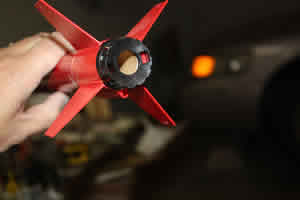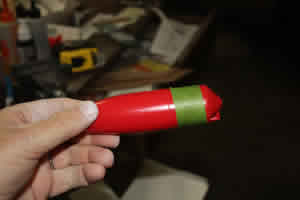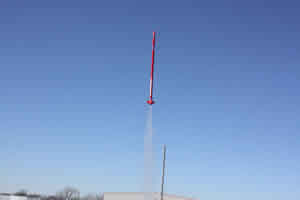| Construction Rating: | starstarstarstarstar_border |
| Flight Rating: | starstarstarstarstar_border |
| Overall Rating: | starstarstarstarstar_border |
| Published: | 2010-01-11 |
| Manufacturer: | Quest  |
 Brief:
Brief:
QuickKit, 4FNC, 18mm motors, Parachute Recovery
While being bummed out about having various projects under construction or repair and still being unable to work on anything in my available time due to drying glue, paint, etc, I decided that one more wouldn't hurt and looked for an easy one near the top of the stack. The Quest Super Eagle was the "winner".
The Super Eagle is a Quick Kit that goes together quickly and easily. It is a 4FNC design with an 18mm motor mount and intended for separation and recovery in two parts, both under parachute.
Construction:
The first step given in the instructions is to tie the end of the Kevlar thread to the end of the elastic cord with an overhand knot. The opposite end of the Kevlar was then supposed to be slipped through the loop on the plastic fin can and secured with a pair of overhand knots used as stoppers. Instead of doing that, I tied the Kevlar to the loop.
The instructions then called for inserting the preslotted motor tube into half of the plastic fin can and then sliding the other half of the fin can in place and cementing the two halves together. Although my kit seemed to be sealed when I opened it, the motor tube was already in place and the two halves of the fin can were together and being held in place with the provided end ring. It was not cemented. I pried apart the two halves and applied Plastruct to cement them together.
The instructions next called for me to use tube type cement to glue the lowest of the body tubes to the fin can. Instead, I used a few drops of epoxy and also used the epoxy to further fasten the end of the shock cord.


The fins were of plastic and were slotted to be received by the slots in the plastic fin can. I had some trouble with 3 out of the four and needed to do some trimming with a razor to get them to fit. When I did, they slid into place and I secured them with Plastruct instead of the recommended tube cement.


The kit comes with two plastic couplers to join the body tubes which are identical in every respect. It also comes with a single read plate designed to be glued into one of the couplers. I used Plastruct again and then fitted the coupler into what would be the foremost of the body tubes. As with the rear tube, I used a drop of epoxy to make the connection.
The instruction say not to glue the nose cone into the body tube. Presumably this is so that the forward section can serve as a payload bay. Since I don't do payload flying, I almost went ahead and glued it but I decided it would hurt nothing to leave it free. I did test fit the nose cone into the forward tube and found that it was extremely loose. I fitted a piece of masking tape onto the shoulder of the cone and it then fit nicely. That completed the payload bay


It took a while to get back to the Super Eagle after getting to this point because life got busy and because I needed a long piece of 1/8" rod to align the launch lugs before gluing the coupler into place. I had 12" pieces lying around the shop but I needed a long piece for this long rocket. When I got a standard rod, it was a simple matter to mix a few drops of epoxy and smear them onto the inside of  the body tube. The upper section of the tube was then pushed into place and the rod was used to align the lugs before the epoxy set.
the body tube. The upper section of the tube was then pushed into place and the rod was used to align the lugs before the epoxy set.
With that, construction was done but I had a slight modification to make.
The kit is designed to recover in 2 sections. I prefer to bring it all back down together. With that in mind, I tied an extra 20" of elastic to the elastic already provided and then tied that to the nose cone.
Finishing:
The rocket was mostly pre-finished. The fin can, couplers and nose cone were all molded from red plastic. The body tubes were already red. All that was needed in the way of finishing was the application of some stickers.


I am not a fan of crack and peel stickers but they are appropriate for a kit of this level. That said, the ones I received were of good quality and nicely complemented the existing colors. Four blue rings of white stars were applied around the BT at locations indicated by the face card.
Four US flags were provided. I placed one on each fin.


The last stickers were a pair of name logos. One was applied to each side of the lowest section of body tube.
With that, my Super Eagle had only to wait for the next launch window.
Construction Rating: 4 out of 5
Flight:
The day of the maiden flight arrived and it was cold and still. I installed a 15" nylon chute and loaded an Estes B6-4 motor. It was then taken to the pad and set up. Lift off looked good with the rocket going straight up. It was a nice, fairly slow takeoff. The coast phase looked pretty good as well. It did not go very high and started to arc over. Ejection occurred when the rocket was horizontal and the chute deployed perfectly. It drifted down and landed a few yards from the pad.


For the second flight, I wanted some more power and I had a new bag of Quest C6-3s sitting handy so I reloaded with one of those. I set up next to the beautiful Dr. Zooch Soyuz that Stu Young had gotten for Christmas and I was glad to wait a bit so I could see it fly. My turn came after waiting a bit more so we could all help to find the pieces of the Soyuz that had its Kevlar burn through. Then it was time. The motor ignited and the rocket lifted even slower than before. The rocket started out fairly straight. It soon started to lean into the direction of travel, though. It was like the motor was struggling to keep it going fast enough. It was easily horizontal or ever a bit down pointing as the coast phase began. It was definitely point down when ejection occurred. It came down safely but it was a bit of a near thing.


For the third flight I wanted to use an Estes C6-3 to compare it to the Quest version. Thus one was installed and it was taken to the pad for its third flight of the day. Ignition occurred right when the button was pushed and it took off well, not much faster than it had with the Quest motor. It boosted straight and did not arc over. It soon passed the altitude to which the Quest motor had taken it. It then coasted a good deal farther. Ejection occurred while it was still moving up but the chute was good and it came home safely.


Flight Rating: 4 out of 5
Summary:
Overall, this was a nice simple kit that looks reasonably good with its precolored parts. The performance was not stellar but it had close to a perfect profile on the B6. The Quest C6 was disappointment but the Estes C6 worked perfectly. My supposition is that this bird was designed and the motors specified when the Quest ones still came from Germany.
Overall Rating: 4 out of 5
Other:
Persons wishing to keep track of this rocket can do so here: http://www.flickr.com/photos/23694991@N03/collections/72157622765370685/
Other Reviews
- Quest Super Eagle By Douglas Gardei
( Contributed - by Douglas Gardei) Brief: The Super Eagle Kit is designed to take the higher impulse 18mm D size motors by Aerotech. Modifications: This is the second Quest Quick Kit I have built. From the first one I know that the motor mount construction is a bit flimsy. The only thing that is preventing the motor from shooting up inside the rocket is two plastic tabs. My concern ...
 |
 |
Flights
 |
 |
D.P. (May 9, 2007)
Joseph Olexa (January 23, 2011)
It looks like Quest had modified the kit at some point. The kit I am flying is only 41 inches long and has no payload section. I get good flights from mine and I like the rocket. I also use a 15" red nylon parachute with mine. Quest has discontinued the kit, but you occasionally see one on Ebay or old stock at hobby shops. It would be nice to see it still in production. The one modification I made was to glue a second small launch lug onto the body to keep it more steady on the launch rod.
Sponsored Ads
 |
 |












H.A.F. (July 14, 2005)